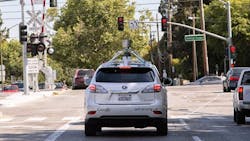Google Reveals Lessons Learned (and Accident Count) from Self-Driving Car Program
Chris Urmson, director of the Google Self-Driving Car program (Fig. 1), has revealed that the small fleet (20+) of Google autonomous cars has been involved in 11 accidents over the almost 1.7 million miles (2.7 million km) the cars have traveled in the six years they’ve been on the road. However, Urmson was adamant that “not once was the self-driving car the cause of the accident” and revealed some of the lessons learned over the journey so far.
Urmson’s statements came in the form of a post on Backchannel, which followed an Associated Press report revealing the accident count in the wake of a new California law requiring Google and others to report accidents involving its self-driving cars to the state. Google reported three accidents between May 2014 and May 2015, while Delphi, which has its own version of a self-driving car, an Audi SQ5, reported its vehicle was struck while waiting to turn at an intersection and not under autonomous control.
In his post, Urmson details that the Google Cars were rear-ended seven times by other cars, sideswiped twice, and hit once by a car running a stop sign, with the majority of the accidents occurring on city streets rather than highways. The 1.7 million miles (2.7 million km) the cars are reported to have traveled combines the distance traveled autonomously and under manual control.
As a point of comparison to human drivers, based on data from the National Highway Traffic Safety Administration (NHTSA), the rate of accidents with “property damage only” in 2012 was around 0.38 per 100,000 miles (161,000 km) driven—taking into account that 54 percent of property damage accidents aren’t even reported. Google has experienced 0.64 accidents per 100,000 miles driven, which is higher than the average.
I wanted to check this against my own driving record. I’ve been driving for 37 years, averaging 15,000 miles (24,000 km) per year. I’ve had four accidents (two of which were my fault), so my accident rate is 0.66 per 100,000 miles, or roughly the same as the Google self-driving cars. You can consider your own performance.
Urmson goes on to detail some of the lessons that the Google team has learned with over a million autonomous miles driven in its test cars and reveals where accidents are most likely to happen.
Perhaps unsurprisingly, Google says that it has seen a lot of people not paying attention to the road. “Our safety drivers routinely see people weaving in and out of their lanes; we’ve spotted people reading books, and even one playing a trumpet,” says Urmson. And that's not even counting all of the drivers talking or texting on smartphones. According to government reports, 3,328 deaths and 421,000 injuries per year are caused by distracted driving, with this now accounting for one in five of all crashes in the U.S. and rising 6% per year.
Of course, automated cars don’t get distracted, never fail to pay attention, and have no blind spots in their 360-degree laser sensors. They also don’t drink, do drugs, or fall asleep at the wheel.
The next highest cause of problems for the Google cars is intersections, which shouldn't be a surprise. It has encountered several instances of people actually driving the wrong way down a divided street, mostly at night—with two cars driving the wrong way at once on one occasion. Other intersection problems included people changing lanes midway through a turn, and suddenly changing their mind about which direction to turn and swerving in front of the self-driving car.
Urmson reports that Google is continuing to test and refine its vehicle’s software, hardware, and sensors, with the eventual goal of having a safe vehicle with no human controls at all. It emphasizes that currently a human safety driver is behind the wheel whenever the cars are on public roads, ready to take over instantly if necessary. However, Urmson didn’t provide statistics on these “operator interventions,” but noted that testing is continuing, with the cars driving 10,000 miles (16,100 km) a month on city streets and highways.
“We’ll continue to drive thousands of miles so we can all better understand the all too common incidents that cause many of us to dislike day-to-day driving—and we’ll continue to work hard on developing a self-driving car that can shoulder this burden for us,” Urmson concluded.
About the Author

Sam Davis Blog
Editor-In-Chief - Power Electronics
Sam Davis was the editor-in-chief of Power Electronics Technology magazine and website that is now part of Electronic Design. He has 18 years experience in electronic engineering design and management, six years in public relations and 25 years as a trade press editor. He holds a BSEE from Case-Western Reserve University, and did graduate work at the same school and UCLA. Sam was the editor for PCIM, the predecessor to Power Electronics Technology, from 1984 to 2004. His engineering experience includes circuit and system design for Litton Systems, Bunker-Ramo, Rocketdyne, and Clevite Corporation.. Design tasks included analog circuits, display systems, power supplies, underwater ordnance systems, and test systems. He also served as a program manager for a Litton Systems Navy program.
Sam is the author of Computer Data Displays, a book published by Prentice-Hall in the U.S. and Japan in 1969. He is also a recipient of the Jesse Neal Award for trade press editorial excellence, and has one patent for naval ship construction that simplifies electronic system integration.

